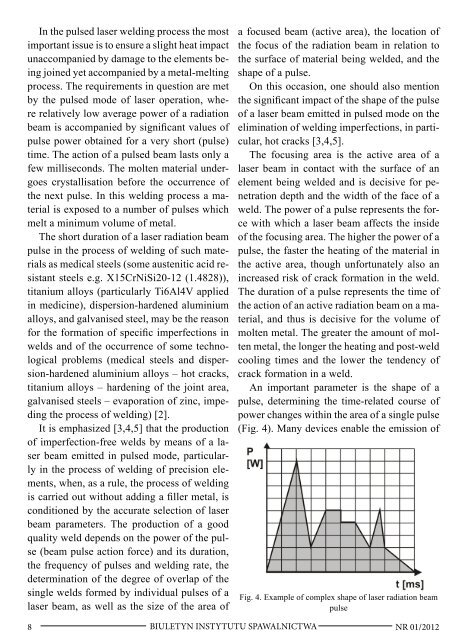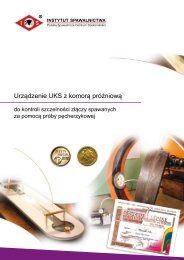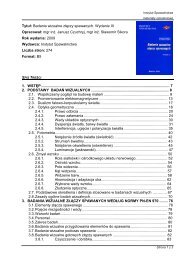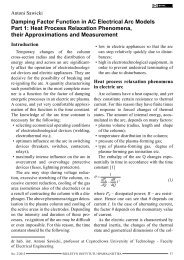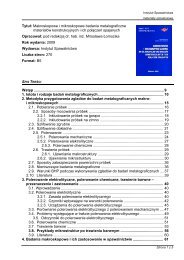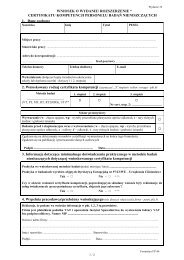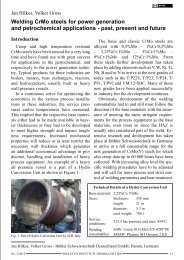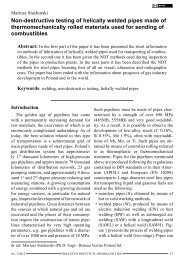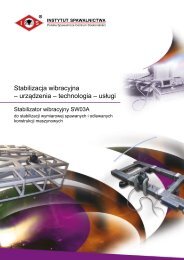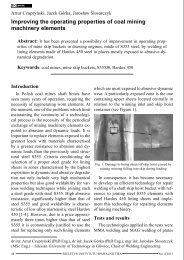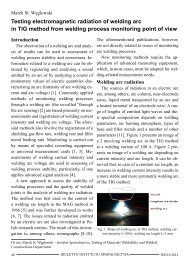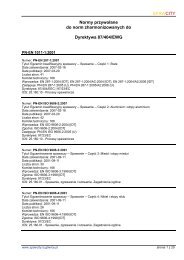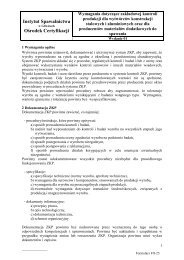Biuletyn Instytutu Spawalnictwa No. 01/2012
Biuletyn Instytutu Spawalnictwa No. 01/2012
Biuletyn Instytutu Spawalnictwa No. 01/2012
Create successful ePaper yourself
Turn your PDF publications into a flip-book with our unique Google optimized e-Paper software.
In the pulsed laser welding process the most<br />
important issue is to ensure a slight heat impact<br />
unaccompanied by damage to the elements being<br />
joined yet accompanied by a metal-melting<br />
process. The requirements in question are met<br />
by the pulsed mode of laser operation, where<br />
relatively low average power of a radiation<br />
beam is accompanied by significant values of<br />
pulse power obtained for a very short (pulse)<br />
time. The action of a pulsed beam lasts only a<br />
few milliseconds. The molten material undergoes<br />
crystallisation before the occurrence of<br />
the next pulse. In this welding process a material<br />
is exposed to a number of pulses which<br />
melt a minimum volume of metal.<br />
The short duration of a laser radiation beam<br />
pulse in the process of welding of such materials<br />
as medical steels (some austenitic acid resistant<br />
steels e.g. X15CrNiSi20-12 (1.4828)),<br />
titanium alloys (particularly Ti6Al4V applied<br />
in medicine), dispersion-hardened aluminium<br />
alloys, and galvanised steel, may be the reason<br />
for the formation of specific imperfections in<br />
welds and of the occurrence of some technological<br />
problems (medical steels and dispersion-hardened<br />
aluminium alloys – hot cracks,<br />
titanium alloys – hardening of the joint area,<br />
galvanised steels – evaporation of zinc, impeding<br />
the process of welding) [2].<br />
It is emphasized [3,4,5] that the production<br />
of imperfection-free welds by means of a laser<br />
beam emitted in pulsed mode, particularly<br />
in the process of welding of precision elements,<br />
when, as a rule, the process of welding<br />
is carried out without adding a filler metal, is<br />
conditioned by the accurate selection of laser<br />
beam parameters. The production of a good<br />
quality weld depends on the power of the pulse<br />
(beam pulse action force) and its duration,<br />
the frequency of pulses and welding rate, the<br />
determination of the degree of overlap of the<br />
single welds formed by individual pulses of a<br />
laser beam, as well as the size of the area of<br />
a focused beam (active area), the location of<br />
the focus of the radiation beam in relation to<br />
the surface of material being welded, and the<br />
shape of a pulse.<br />
On this occasion, one should also mention<br />
the significant impact of the shape of the pulse<br />
of a laser beam emitted in pulsed mode on the<br />
elimination of welding imperfections, in particular,<br />
hot cracks [3,4,5].<br />
The focusing area is the active area of a<br />
laser beam in contact with the surface of an<br />
element being welded and is decisive for penetration<br />
depth and the width of the face of a<br />
weld. The power of a pulse represents the force<br />
with which a laser beam affects the inside<br />
of the focusing area. The higher the power of a<br />
pulse, the faster the heating of the material in<br />
the active area, though unfortunately also an<br />
increased risk of crack formation in the weld.<br />
The duration of a pulse represents the time of<br />
the action of an active radiation beam on a material,<br />
and thus is decisive for the volume of<br />
molten metal. The greater the amount of molten<br />
metal, the longer the heating and post-weld<br />
cooling times and the lower the tendency of<br />
crack formation in a weld.<br />
An important parameter is the shape of a<br />
pulse, determining the time-related course of<br />
power changes within the area of a single pulse<br />
(Fig. 4). Many devices enable the emission of<br />
Fig. 4. Example of complex shape of laser radiation beam<br />
pulse<br />
8 BIULETYN INSTYTUTU SPAWALNICTWA<br />
NR <strong>01</strong>/2<strong>01</strong>2


